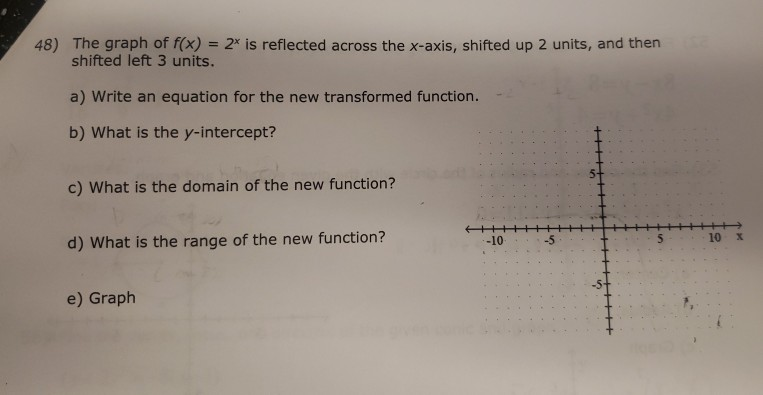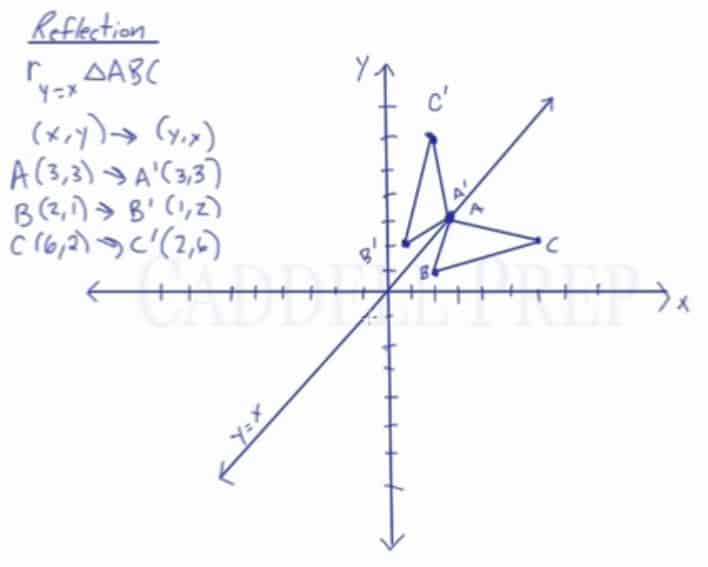Given the function f(x)= is reflected across the xaxis to create g(x) The rule of reflection across x axis is then;The graph of g(x) = ()x is the graph of f(x) = 2x reflected over the yaxis Which graph represents g(x)?Reflecting Over the xaxis Another effect of " a " is to reflect the graph across the x axis When the parent function f (x) = x2 has an a value that is less than 0, the graph reflects across the x axis before it is transformed The graph below represents the function f (x) = x2 In function notation, this reflection is represented by a
Transformations Of Functions Mathbitsnotebook A1 Ccss Math
Which graph shows f(x) = x 2 reflected over the x-axis
Which graph shows f(x) = x 2 reflected over the x-axis-Let y = f(x) be a function In the above function, if we want to do reflection through the yaxis, x has to be replaced by x and we get the new function y = f(x) The graph of y = f(x) can be obtained by reflecting the graph of y = f(x) through the yaxisThe graph of the function f(x)=log6(x) is stretched vertically by a factor of 3, reflected over the xaxis, reflected over the yaxis, and shifted up by 4 units Find the equation of the function g(x) described above




Reflect Function About Y Axis F X Expii
B 2/3 Chelsea is graphing the function f(x) = ()xFirst image A Which function represents g(x), a reflection of If f (x) Makes you reflect over the x axis Then e^x will do a neccesary reflection for reflecting it about y = 2 Then I add 2 to the end of f (x) = (e^x)2 = 2e^x Although on my homework they say the correct answer is 4 e^x Saying I needed to time 2 for some reason, which is where I lose understanding
And y=f (x) is a reflection across the yaxis because the negative is in the second term of the right hand side of the equation (x) and because the second coordinate we plot in a graph is the Ycoordinate and y=f (x) that's easy to remember because both are negative and you just reflect the function in both axisThe axis of symmetry is simply the vertical line that we are performing the reflection across It can be the yaxis, or any vertical line with the equation x = constant, like x = 2, x = 16, etc Finding the axis of symmetry, like plotting the reflections themselves, is also a simple processOr therefore, the function g(x) = Since, this g(x) is an exponential function it is of the form of where a is the initial value On comparing we get ;
Functions of graphs can be transformed to show shifts and reflections Graphic designers and 3D modellers use transformations of graphs to design objects and imagesB The table represents an exponential function What is the multiplicative rate of change of the function?Can someone help Nothing, Jose, nothing changes y = x 2 is symmetric with respect to the yaxis Plug in numbers and try it out The negative of all your numbers should give you the same result as the positive ones




48 The Graph Of F X 2x Is Reflected Across The Chegg Com



Biomath Transformation Of Graphs
G(x) = 2/5 (10)x The function g(x) = 8(4x) is reflected across the xaxis to create f(x) What is the equation for f(x)?8 Which graph represents a reflection of f(x) = 2(04)x across the yaxis?Graph functions using reflections about the xaxis and the yaxis Another transformation that can be applied to a function is a reflection over the x – or y axis A vertical reflection reflects a graph vertically across the x axis, while a horizontal reflection reflects a graph horizontally across the y axis If the graph #y=x^3 5# is reflected in the x axis what is the new equation?



2



1
G(x) is shifted 2 units to the right and reflected over the xaxis g(x) is shifted 2 units to the left and reflected over the xaxis g(x) is shifted 2 units to the right and 1 unit up g(x) is shifted 2 units to the right and 1 unit downReflect {eq}f(x) = x^2 {/eq} about the {eq}y {/eq}axis Relection across the yaxis When we are reflecting a function over the yaxis, what happens is that the points on the right side of the y The graph of g(x) is the graph of f(x) reflected over the xaxis, translated 6 units to the left and shifted down 3 units Write the equation for g(x) Algebra 2 the function f(x)=5x The graph of g(x) is f(x) vertically compressed by a factor of 1/4 and reflected in the x axis What is the function rule for g(x)




The Parent Function F X 2 Xis Reflected Across The X Axis Then Shifted 2 Units Left And 6 Units Brainly Com



Which Graph Represents A Reflection Of F X 2 0 4 X Across The Y Axis Studyrankersonline
Reflect over xaxis Down 2 Reflect over yaxis Up 2 Reflect over xaxis Up 2 Reflect over yaxis Down 2 s Question 11 SURVEY 30 seconds Report an issue Q g(x)=f(x)4 Describe the transformation to f(x) that results in g(x) answer choices f(x) has been translated down 4 f(x) has been translated up 4D To reflect a graph over the line y = x, switch the x and y coordinates of each point on the graph For this graph, Point V (2,1) becomes (1,2) and point Z (0,1) becomes (1,0) Eliminate any graph that does not include these three points Note that point X (1,1) remains the same"A reflection through the x axis" And also write the formula that gives the requested transformation and draw the graph of both the given function and the transformed function Answer Step 1 Since we do reflection transformation through the xaxis, we have to replace y by y in the given function y = √x Step 2 So, the formula that gives the requested transformation is y = √x



Ch 3 4




Learn About Reflection Over The Line Y X Caddell Prep Online
Which function represents g(x), a reflection of f(x) = 2/5 (10)x across the xaxis? Correct answers 1 question How does the graph of g(x) = −(x − 2)4 compare to the parent function of f(x) = x4? To reflect a graph, f(x) over the xaxis, you take f(x) So if f(x)=x^2, then f(x) is x^2 Then g(x)=x^2 is the reflection of your function f(x) over the xaxis




Graphing Reflecting Functions Study Com




Which Represents The Reflection Of F X Over The Y Axis Amazing News



0 件のコメント:
コメントを投稿